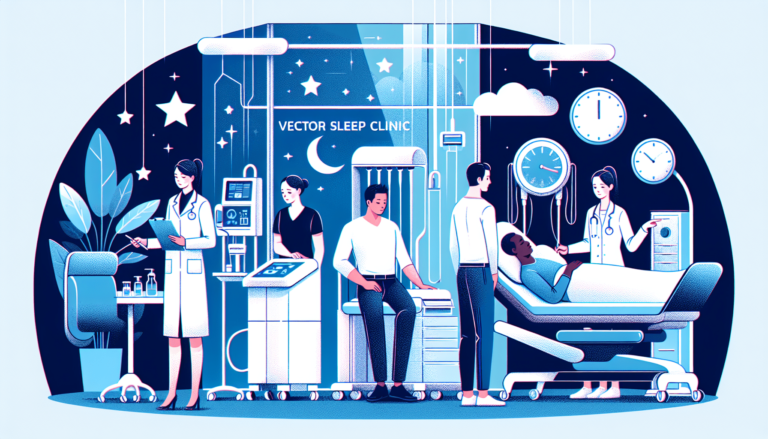Discover Better Sleep: Benefits of Sleep Diagnostic Centers

Enhancing Your Rest: Exploring the Advantages of Sleep Diagnostic Centers
Imagine drifting into a peaceful slumber, only to wake up feeling as if you’ve barely rested.
For many, this is not just a disrupted night but a profound issue affecting their daily lives.
Enter the realm of sleep diagnostic centers, specialized clinics designed to unravel the mysteries of sleep disturbances.
These centers use cutting-edge technology and a comprehensive approach to diagnose and treat a wide range of sleep disorders, from the well-known apnea to the elusive narcolepsy.
Stay tuned as we delve deeper into how these centers can transform your sleep, and by extension, your health and well-being.
Unveiling the Benefits: Why Choose a Sleep Diagnostic Center
Choosing a sleep diagnostic center transforms an often overlooked aspect of health into a focal point of wellness, initiating a journey toward improved rest and, consequently, a better quality of life.
The advent of specialized sleep centers has ushered in an era of improved diagnosis, paving the way for treatments tailored to the unique needs of each patient.
These facilities provide not just cutting-edge sleep technology but also access to professionals whose expertise is pivotal in unraveling the complexities of sleep disorders.
Whether it’s obstructive sleep apnea, insomnia, narcolepsy, or another condition impacting sleep, the role of professional sleep specialists at these centers is invaluable.
Beyond diagnosis, these centers offer comprehensive care designed to address not only the symptoms but the underlying causes of sleep disturbances, embodying a holistic approach to patient well-being.
Improved Diagnosis for Better Treatment
The cornerstone of effective treatment lies in accurate diagnosis, something that sleep diagnostic centers excel at. The utilization of advanced technologies such as polysomnography allows for an in-depth evaluation of sleep patterns, providing critical data that guides the formulation of personalized treatment plans.
At these centers, the synergy between cutting-edge diagnostic tools and the seasoned expertise of sleep specialists creates an environment where understanding the nuances of each patient’s condition becomes achievable. This precise approach ensures that therapies, whether they involve continuous positive airway pressure or cognitive behavioral therapy, are aptly matched to the patient’s needs, enhancing the likelihood of successful outcomes.
Tailored Sleep Solutions and Support
Embracing the services of a sleep diagnostic center means entering a space where every aspect of your sleep disorder is meticulously examined to craft a care plan that resonates with your unique health profile. It’s not just about applying a one-size-fits-all solution; it’s about understanding your personal health puzzle and assembling the pieces through specialized care. This attention to detail ensures that whether your challenge is managing obstructive sleep apnea, combating insomnia, or navigating the complexities of narcolepsy, the therapeutic strategies you receive are as unique as you are.
Support doesn’t stop after diagnosis or the initial setup of a treatment plan at these centers. Continuous engagement and follow-up are cornerstones of the tailored support system they offer. Your progress is closely monitored, allowing for adjustments to be made as needed, ensuring that your journey back to restful nights is on a consistent, upward trajectory. This dynamic approach to support means that you’re never alone in your quest for better sleep, providing a comforting palm along the winding path to improved wellness and vitality.
Access to Cutting-Edge Sleep Technology
The provision of cutting-edge sleep technology is a standout feature when selecting a sleep diagnostic center. These centers are equipped with the latest advancements in sleep research and diagnostic tools, enabling precision in uncovering the nature and extent of various sleep disorders.
Among these technologies, polysomnography leads the charge:
- This comprehensive sleep study allows specialists to monitor numerous physiological parameters during sleep, shedding light on complex sleep conditions.
- The utilization of continuous positive airway pressure machines in therapy showcases the centers’ commitment to leveraging technology for optimized patient care.
- Moreover, advancements in cognitive behavioral therapy for insomnia illustrate the marriage of psychology with technology to enhance treatment efficacy.
The Role of Professional Sleep Specialists
The essence of sleep diagnostic centers is heightened by the role of professional sleep specialists who embody the bridge between complex sleep disorders and viable solutions. Their proficiency in fields such as sleep medicine, neurology, and even psychiatry equips them with a versatile approach to addressing a spectrum of sleep-related issues: from apnea and insomnia to more elusive conditions like narcolepsy and restless legs syndrome.
| Role | Responsibility | Specialization |
|---|---|---|
| Sleep Specialist | Diagnosis and Treatment of Sleep Disorders | Sleep Medicine, Neurology, and Psychiatry |
| Therapist | Implementation of Behavioral and Therapeutic Interventions | Cognitive-Behavioral Therapy, Physical Therapy |
| Technician | Conducting Sleep Studies and Managing Equipment | Polysomnography and CPAP Management |
A critical aspect they bring to the table is their ability to personalize treatment plans, recognizing that the path to improving sleep quality is not universal. Their depth of knowledge ensures that every strategy, whether it involves medication or use of medical devices like CPAP machines, or suggested lifestyle modifications, is tailored to the individual’s unique health history and specific needs, paving the way for enhanced overall well-being.
Comprehensive Care Beyond Diagnosis
The journey through a sleep diagnostic center unveils a path focused not solely on identifying sleep disorders but also on fostering long-term health and wellness. It’s the dedication to comprehensive care that sets these institutions apart: an unwavering commitment spanning from initial consultation to post-treatment support and beyond.
Following a thorough evaluation and personalized treatment strategy, the continuum of care extends to embrace a spectrum of support services designed to ensure sustained progress and adjustment to healthier sleep patterns. This holistic approach underscores the center’s dedication to not just addressing the immediate concerns but securing enduring wellness for each patient:
- Regular follow-up appointments are needed to evaluate the effectiveness of treatment plans and make necessary adjustments.
- Access to patient portals for ongoing communication, allowing patients to share updates and receive guidance in real time.
- Education programs focusing on sleep hygiene and lifestyle modifications complement medical treatments for a holistic approach to sleep wellness.
In this way, the choice of a sleep diagnostic center isn’t merely about solving a problem—it’s about embarking on a journey of transformation that prioritizes sleep as a cornerstone of health, inviting a reawakening to the joys and energies of life refreshed by sleep onset latency.
Now that we’ve uncovered the myriad advantages of opting for a sleep diagnostic center, let’s pivot to the core of the matter. Discover how these centers excel at pinpointing and managing sleep disorders with precision and care.
The crescendo of this symphony, flowing at the rate of your heartbeat, is the charting of a course for the journey post-diagnosis. It’s similar to setting sails on unexplored waters after charting a meticulous course. Your interaction with the sleep specialist isn’t a cameo, but rather a series of interlinked narratives aimed at positively altering the storyline of your nocturnal escapades.
After your sleep center visit, your compass should point towards a healthy sleep lifestyle. This isn’t just a feat achievable by sleep specialists alone—it’s a group project, where you’re the led with the sleep specialist as your guide, aiding in balancing vitamins and supplements, quelling insomnia demons, or training you in the art of sleeping itself.
- Follow-up visits to sharpen the focus of your treatment
- Adherence to prescribed treatment plans, whether it’s lifestyle changes, use of sleeping aids, or applying breathing devices for conditions like sleep apnea
- Adjusting daily routines to nurture a healthy sleep lifestyle
- Regular monitoring and adjustment of the treatment plan as needed
Stepping away from the diagnostic sleep center doesn’t denote an end, but rather the onset of a restful journey, filled with tranquil nights and energized mornings. Armed with newfound knowledge about yourself, you’re like Galileo, ready to re-establish the truths about your universe. This journey might appear as intimidating as the ocean on a stormy night, but remember—you now have a map, a compass and a faithful guide at your command. These are the sails that’ll keep you afloat in the sea of sleep disorders, ushering you towards the blissful island of sleep-land.
Identifying and Treating Sleep Disorders Effectively
The journey to reclaiming quality sleep begins with a nuanced understanding of the sleep challenges we face.
Sleep disorders, a sprawling term, encompass a range of issues from the well-known obstructive sleep apnea and insomnia to the less commonly discussed but equally disruptive conditions like narcolepsy and restless legs syndrome.
Grappling with these requires an initial, thorough assessment, a cornerstone in the foundation of effective treatment.
Sleep diagnostic centers stand out by offering a highly specific process for evaluating sleep issues, harnessing a blend of advanced technology and deep clinical expertise.
This not only illuminates the specific nature of the disorder but also paves the way for creating bespoke treatment plans.
Crucially, the journey doesn’t halt at the prescription of treatment; it involves an ongoing partnership, where adjustments are dynamically made based on the patient’s progress.
This ensures a tailored pathway towards sustainable sleep health, making it imperative that we dive deeply into each of these pivotal steps.
Understanding Different Types of Sleep Disorders
Embarking on a journey to enhance rest begins with grasping the myriad sleep disorders that can disrupt our nightly repose. Conditions such as obstructive sleep apnea and insomnia are frequently discussed, yet the sleep disorder spectrum is broad, including less commonly known issues like narcolepsy, which challenges our ability to regulate sleep-wake cycles, and restless legs syndrome, marked by an irresistible urge to move the legs.
It’s intriguing to note that each disorder not only affects sleep in unique ways but also reflects deeper health concerns, ranging from neurological to cardiovascular issues. For instance, sleep apnea is not just about disturbed sleep; it’s linked with heightened risks for hypertension and stroke, necessitating a nuanced understanding and approach to treatment. This complexity underscores the importance of thorough diagnostics and personalized therapy plans that sleep diagnostic centers excel at providing.
The Process of Sleep Assessment Explained
The voyage to alleviate sleep dissatisfaction begins with an accurate assessment, a fundamental aspect where sleep diagnostic centers shine immensely. By employing a suite of advanced diagnostic procedures, including polysomnography, professionals can dissect the intricacies of a patient’s sleep patterns, crucial for the identification of specific sleep disorders.
Embarking on this journey with a sleep diagnostic center is akin to unlocking a door to comprehensive insights into one’s sleep health. This pivotal step ensures not just a snapshot of sleep behavior, but a detailed exploration, allowing physicians to craft highly effective, personalized treatment strategies.
How Sleep Diagnostic Centers Tailor Treatment Plans
Stepping into a sleep diagnostic center, the first thing I notice is the depth of personalization in their treatment plans: it’s like tailoring a suit, but for your sleep health. The care begins with a detailed mapping of one’s sleep disturbances, leaned on technology and expertise, revealing not just the what but the why behind each sleep issue.
- Gathering comprehensive data through advanced diagnostic tests.
- Drawing from a rich pool of sleep medicine knowledge to interpret results.
- Designing a treatment strategy that aligns perfectly with the patient’s lifestyle, needs, and the specific characteristics of their sleep disorder.
This personalized approach is not a luxury but a necessity for converting the vast stream of data into actionable, effective treatment plans. By putting the patient’s unique sleep profile at the core of the decision-making process, sleep diagnostic centers ensure interventions are not just theoretically sound but practically impactful, fostering a path to improved sleep that feels genuinely tailored to me. Continuous positive airway pressure
Monitoring Progress and Adjusting Treatments
Embarking on treatment at a sleep diagnostic center introduced a pivotal shift in how I conceive sleep health. The meticulous monitoring of my progress became a cornerstone of my treatment journey, ensuring adjustments to my care plan reflected real-time insights into my condition and response to therapy.
This tailored approach extended beyond initial treatment to incorporate regular evaluations. It ensured that my therapy evolved in tandem with my changing needs and health status, underscoring the center’s commitment to not merely initiating care but adapting it to foster enduring sleep wellness.
Exploring the landscape of sleep disorders sheds light on challenges and triumphs. Next, let’s pivot to the technological revolution transforming how we diagnose these conditions.
The Role of Technology in Sleep Diagnostics
Navigating the landscape of sleep diagnostics, it becomes evident how integral technology is in revolutionizing our approach to understanding and improving sleep health.
The infusion of innovative tools doesn’t just refine accuracy in sleep analysis; it transforms the entire diagnostic process into a highly interactive, patient-centered experience.
From the sophisticated algorithms driving wearable sleep trackers to the immediacy of real-time monitoring systems, technology stands at the forefront, making it possible to not only pinpoint sleep disturbances with precision but also to adapt treatments in ways that were unimaginable just a few years ago.
As we delve deeper, we uncover the profound impact these technological advancements have on enhancing both the diagnosis and treatment of sleep disorders, ensuring a more nuanced and effective pathway to restorative sleep.
Innovative Tools for Accurate Sleep Analysis
Delving into the heart of sleep diagnostics, it becomes increasingly clear that the precision of sleep analysis hinges on the innovative tools at our disposal. The sophistication of modern diagnostic machines like polysomnography allows us to capture a comprehensive portrait of sleep, pinpointing disruptions with an accuracy that was once beyond our reach.
Moving beyond traditional methods, technologies such as wearable sleep trackers and advanced software algorithms are redefining how we approach sleep analysis. These tools not only facilitate a deeper understanding of sleep patterns but also empower us to detect subtleties in sleep disorders that might otherwise go unnoticed, setting a new standard for accuracy and personalization in sleep health care.
The Impact of Wearable Sleep Trackers
The surge in wearable sleep trackers has revolutionized the path to understanding our sleep patterns on a much deeper level. By offering continuous, real-time monitoring, these devices provide insights into the quality and quantity of sleep, revealing patterns and disruptions that may not be evident through traditional diagnostic methods.
This wealth of data, harvested from the comfort of our own beds, empowers both patients and sleep specialists to make informed decisions about interventions and adjustments to treatment plans. The capability to track progress over time allows for a dynamic approach to sleep management, fine-tuning therapies to achieve optimal sleep health and breathing.
| Feature | Impact on Sleep Diagnostics | Benefit to Patient |
|---|---|---|
| Continuous Monitoring | Provides a detailed view of sleep patterns over extended periods | Enables personalized adjustments to improve sleep quality |
| Real-Time Data Collection | Facilitates immediate identification of sleep disruptions | Allows for quicker, more informed treatment modifications |
| User-Friendly Interface | Demystifies sleep data, making it accessible to specialists and patients | Empowers patients to engage actively in their sleep health management |
How Real-Time Monitoring Enhances Treatment
One of the most transformative advantages I’ve observed in utilizing real-time monitoring within sleep diagnostics is its ability to sharpen the precision of treatment adjustments. Instead of relying on periodic reviews, real-time data feeds into treatment algorithms continuously, allowing for immediate intervention when sleep patterns deviate from the desired trajectory. This dynamic adjustment not only enhances the effectiveness of treatments but also significantly reduces the duration of trial and error that patients have to endure.
Moreover, real-time monitoring fosters a deeper connection between the patient and their therapeutic journey. By having access to this ongoing stream of data, I could see the direct impact of my lifestyle choices and therapeutic compliance on my sleep quality. It’s an empowering aspect of sleep diagnostics, turning abstract numbers into actionable insights, thus motivating sustained engagement and adherence to the treatment plan prescribed by the sleep diagnostic center.
The journey through the fascinating world of sleep diagnostics has laid the groundwork. Let’s pivot to the transformative path from diagnosis to recovery, charting a patient’s bold strides towards rejuvenation.
From Diagnosis to Recovery: A Patient’s Journey
My voyage through the realm of sleep diagnostic centers began with an overarching goal: to reclaim the restorative sleep that had eluded me for years.
This journey, marked by its comprehensive framework, unfolded in meticulously planned steps, each designed to bring me closer to that goal.
It commenced with an initial consultation and thorough evaluation, laying the foundation for what would become a transformative experience.
Progressing to a sleep study, I found myself enveloped in an environment equipped to unravel the mysteries of my sleep patterns.
Following this, a detailed interpretation session with a specialist opened my eyes to the nuances of my condition, setting the stage for the creation of a personalized treatment plan.
But the journey didn’t end there; ongoing support and scheduled follow-ups ensured that the path to better sleep was consistently adapted to my evolving needs.
This sequence, from diagnosis to recovery, not only offered me hope but also a tangible plan toward achieving optimal sleep health.
Step 1: Initial Consultation and Evaluation
The moment I stepped into the sleep diagnostic center for my initial consultation, it signified the beginning of a pivotal phase in my journey towards better sleep health. This initial meeting was an opportunity to share my sleep struggles and health history with a professional who was poised to guide me through the subsequent stages of diagnosis and treatment.
- Sharing my sleep history and struggles with the specialist.
- Receiving professional guidance on the next steps in the diagnostic process.
Following this introductory conversation, a thorough evaluation was scheduled. It involved a series of questions and assessments designed to gather comprehensive insights into my sleep patterns and potential underlying conditions. This detailed evaluation laid the groundwork for a highly personalized approach to my sleep issues, ensuring that the treatment plan would be specifically tailored to address my needs.
Step 2: Undergoing a Sleep Study
Entering the phase of undergoing a sleep study marked a crucial moment in my journey towards understanding my sleep patterns comprehensively. Surrounded by the advanced technology and expertise at the sleep diagnostic center, I felt a profound sense of hope and anticipation, confident that this step would illuminate the path toward addressing my sleep concerns.
The experience of the sleep study itself was far from what I had imagined; it was conducted with utmost sensitivity and professionalism, ensuring my comfort throughout. Every detail gathered from this overnight monitoring session served as a keystone, offering invaluable insights that would shape the subsequent strategies for enhancing my sleep health.
Step 3: Interpreting Results With a Specialist
The moment of interpreting results with a specialist stands out as a transformational turning point in my journey. This detailed discussion bridged the gap between raw data and actionable insights, where the specialist meticulously decoded the complexities of my sleep patterns, translating them into a coherent narrative that shed light on the underlying causes of my sleep disruptions.
Armed with these insights, we collaboratively charted a course for my treatment, marking a significant milestone toward enhancing my rest. The specialist’s ability to articulate the implications of the findings and how they would influence my personalized treatment plan exemplified the seamless integration of expertise and empathy that defines the essence of care at sleep diagnostic centers.
Step 4: Personalized Treatment Plan Creation
The creation of a personalized treatment plan was nothing short of revelatory: a moment where the accumulation of data, expertise, and patient-centric dialogue converged to chart a tailored path towards rejuvenating sleep. This crucial step felt like a blueprint being drawn, specifically designed to navigate the complexities of my individual sleep challenges.
| Phase | Action | Impact |
|---|---|---|
| Personalized Treatment Plan Creation | Developing a bespoke plan based on diagnostic results and patient feedback. | A direct approach aimed at addressing specific sleep disorders with targeted strategies. |
Within the sanctity of this process, decisions about therapies, whether it be employing technology like CPAP machines for sleep apnea or integrating behavioral strategies for insomnia, were made with an incredible sense of deliberation and care. It was here that I truly grasped the significance of a customized care plan, tailored not only to address my symptoms but also to fit seamlessly into my lifestyle and preferences, amplifying its potential for success.
Step 5: Ongoing Support and Follow-Ups
The moment my personalized treatment plan was set in motion, the journey with the sleep diagnostic center transitioned into a phase of ongoing support and regular follow-ups. This continuous engagement represented a safety net, a reassurance that adjustments could be made swiftly if my progress veered off the anticipated path, and it underscored the center’s commitment to not just a temporary fix but my long-term wellness.
Having access to follow-up appointments and continuous communication with the center empowered me to feel an active participant in my care. This part of the journey was instrumental in refining my treatment plan, ensuring it adapted to the evolving nuances of my sleep patterns and health status, effectively maintaining the trajectory towards achieving and sustaining optimal rest.
As we turn the page on understanding the roadmap of diagnosis and recovery, let’s ignite our curiosity about a holistic approach to sleep health. Dive with me into a world where the body, mind, and spirit collaborate for transformative rest.
Embracing a Holistic Approach to Sleep Health
Turning our focus towards a holistic approach to sleep health directs our attention to the indispensable role of lifestyle and behavioral adjustments.
Recognizing that restorative sleep isn’t solely achieved through medical interventions, we delve into the transformative power of mindfulness and relaxation techniques.
These practices stand as pillars, supporting the mind’s ability to unwind and transition into peaceful slumber.
Further, the intertwining of diet and exercise underscores their significant impact on sleep quality.
By nurturing our bodies with nutritious foods and regular physical activity, we forge a pathway to enhanced sleep, demonstrating the profound interconnectedness of our lifestyle choices and sleep onset latency.
The Importance of Lifestyle and Behavioral Changes
Recognizing the crucial role of lifestyle and behavioral adjustments is a game-changer in the quest for improved sleep. It dawned on me: our day-to-day choices, from the foods we eat to our physical activity levels, profoundly influence our sleep quality.
This realization sparked a commitment to integrate mindful practices into my routine, aiming to cultivate a conducive sleep environment. The journey towards better sleep health doesn’t stop at clinical interventions; it extends into every nuance of our lifestyle: insurance
- Adopting a regular exercise regime to enhance physical well-being and promote restfulness.
- Maintaining a balanced diet, rich in nutrients, to support overall health and sleep.
- Implementing relaxation techniques before bed, such as meditation, to prepare the mind and body for sleep.
Integrating Mindfulness and Relaxation Techniques
My journey into the realm of sleep diagnostic centers illuminated the profound impact of integrating mindfulness and relaxation techniques into my routine. This exploration taught me the power of these practices to calm the mind and gently usher it towards a state of rest, revealing a crucial piece of the puzzle in achieving restorative sleep.
Through guided meditation sessions and breathing exercises recommended by my sleep specialists, I discovered an effective strategy to diminish the day’s stressors. It became clear that fostering a tranquil environment for sleep wasn’t just beneficial; it was essential, transforming my bedroom into a sanctuary for peace and relaxation.
Diet and Exercise: Their Impact on Sleep
The interplay between diet and exercise exerts a profound influence on the quality of sleep, a truth I’ve come to appreciate deeply through my journey. Nourishing my body with balanced, healthful meals directly impacts my ability to fall and stay asleep: a lesson underscored by every restful night that follows a day of mindful eating.
- Choosing foods rich in tryptophan and magnesium for dinner promotes relaxation and sleep readiness.
- Engaging in regular aerobic exercise boosts the duration and depth of sleep, making each morning more refreshing.
Similarly, integrating a consistent exercise routine into my daily schedule has not just elevated my physical health but significantly enhanced my sleep quality. The exertion from activities like jogging and yoga improves my sleep onset latency, allowing me to drift into slumber more effortlessly and enjoy a deeper, more restorative sleep.
Shifting gears towards practical solutions, the quest for optimal sleep doesn’t stop with theories alone. Let’s gear up to locate a sleep diagnostic center that promises to transform theory into action for your better slumber.
Finding the Right Sleep Diagnostic Center Near You
Navigating the landscape to pinpoint the sleep diagnostic center that suits your needs best is akin to assembling a unique puzzle, where each piece represents a critical factor deserving attention.
This part of the journey underscores the importance of conducting a thorough examination of potential sleep centers, blending practical considerations with personalized criteria.
I’m preparing to delve into topics such as factors crucial to the evaluation process of these centers, crafting a list of pointed questions aimed at uncovering the essence of each facility’s approach to diagnosis and treatment.
Also, I plan to harness the power of reviews and testimonials, a step that promises to lend transparency and real-world insights into the experiences of others who’ve walked this path before me.
This approach ensures that the sleep diagnostic center I choose is not only equipped with the right technology and expertise but is also a place where I feel supported and understood throughout my journey towards better sleep.
Factors to Consider When Choosing a Sleep Center
In my search for a sleep diagnostic center, one crucial factor I considered was the depth and breadth of their diagnostic capabilities. It was essential for me to choose a center that not only had the latest technological advancements but also a team of healthcare professionals who could interpret the data with precision, aligning the treatment with my unique sleep patterns.
Another aspect that significantly influenced my decision was the center’s commitment to personalized care. I sought a facility where the communication felt open and my concerns were addressed with empathy, ensuring a partnership that valued my input in the journey towards achieving restful sleep.
Questions to Ask Before Selecting a Diagnostic Center
Before deciding on a sleep diagnostic center, I prioritized forming a set of strategic questions aimed at shedding light on each facility’s approach to patient care and their diagnostic processes. Among my inquiries, I focused on understanding the variety of sleep studies they offer, ensuring they could accurately pinpoint my specific sleep disorder.
I also explored their follow-up support system, questioning how they maintain communication with patients post-diagnosis and during treatment. This was crucial for me, as ongoing support is pivotal in adapting treatment plans to align with my progress, providing a scaffold for continuous improvement in my sleep health.
Utilizing Reviews and Testimonials in Your Decision
Embarking on the quest for the ideal sleep diagnostic center, I discovered the invaluable role of reviews and testimonials. These firsthand accounts painted a vivid picture of what to expect, offering insights into patient satisfaction, the effectiveness of treatment plans, and the quality of care provided by the center’s staff.
| Criteria | Insights Gleaned from Reviews | Impact on Decision |
|---|---|---|
| Patient Satisfaction | Personal experiences of comfort and understanding | Highly influenced my choice, emphasizing the importance of empathy and patient care |
| Effectiveness of Treatment Plans | Accounts of improved sleep quality and health outcomes | Assured me of the center’s capacity to tailor treatments effectively |
| Quality of Care | Descriptions of professionals’ expertise and supportiveness | Reinforced my preference for centers known for their excellence in service |
Wading through the myriad of experiences shared by previous patients, I was able to identify patterns and common themes that resonated with my own expectations. This exploration not only guided me towards a sleep diagnostic center renowned for its exemplary care but also instilled a confidence that my journey towards improved rest would be understood and supported every step of the way.
Frequently Asked Questions
Does anyone ever pass a sleep apnea test?
Yes, individuals can indeed pass a sleep apnea test if the results show minimal to no occurrences of apnea events during the night. This essentially means that their breathing does not get interrupted frequently enough to meet the criteria for a diagnosis of obstructive sleep apnea or another sleep disorder related to breathing issues.
What is a sleep doctor called?
A sleep doctor is commonly referred to as a sleep medicine specialist. These professionals typically hold board certifications in sleep medicine from respected bodies, such as the American Academy of Sleep Medicine.
What can a sleep study diagnose?
A sleep study, often conducted at a sleep diagnostic and treatment center like Vector Sleep Diagnostic Center, can unearth a treasure trove of insights into a patient’s nighttime behaviors and potential disorders. Notably, it’s geared towards diagnosing conditions such as obstructive sleep apnea, insomnia, narcolepsy, restless legs syndrome, and various forms of parasomnia, among others.
Crucially, sleep studies play a pivotal role in detecting less obvious yet significant ailments like central sleep apnea, periodic limb movement disorder, and even circadian rhythm sleep disorders, revealing the complex interplay between sleep and overall health. Through a blend of technologies, including polysomnography and multiple sleep latency tests, these studies offer a window into the patient’s sleep architecture, breathing patterns, oxygen levels, and brain wave activity.
The results? They significantly influence management strategies, guiding physicians in selecting the most suitable therapies, ranging from continuous positive airway pressure (CPAP) for apnea to cognitive behavioral therapy for insomnia. Absolutely, feel free to provide the link you want me to generate an anchor text for, and I’ll be more than happy to assist in emphasizing the importance of diagnosing and treating sleep disorders to improve quality of life and prevent more serious health complications down the line.
Can someone stay with you during a sleep study?
Typically, most sleep diagnostic centers aim to replicate your natural sleep environment as closely as possible, meaning that having someone stay with you during a sleep study isn’t standard practice. However, exceptions can be made for specific circumstances, such as minors or patients needing special assistance, so it’s always best to inquire directly with the facility.
How many hours of sleep do you need for a sleep study?
Typically, a sleep study requires you to sleep for at least six to eight hours to gather sufficient data. The exact duration can vary based on the specific conditions being tested and the protocols of the sleep diagnostic and treatment center.






